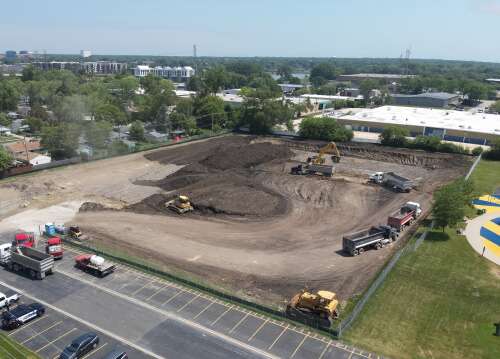A stormwater detention basin is being built in Wheeling’s South Dunhurst neighborhood near Twain Elementary School and Twain Park.
Courtesy of Wheeling
A $6 million flood-prevention project now underway in Wheeling should end decades of soggy suffering for residents of one neighborhood.
The work targets the South Dunhurst subdivision, which is south of Dundee Road and east of Elmhurst Road. The neighborhood was built in the 1950s, and it doesn’t have a modern, underground stormwater system to keep its 183 homes dry.
“There are no pipes in the neighborhood,” Wheeling Public Works Director Dan Kaup said. “The water has nowhere to go.”
As a result, water accumulates on streets and in yards during every heavy rainstorm, typically two or three times a year, Village Manager Jon Sfondilis said. Houses rarely take on water, but cars driving down flooded streets can create wakes that splash up to front doors and into garages.
The new project should change that.
A large detention pond is being built, and thousands of feet of large sewer pipes — with street-level inlets and drains — will be installed underground to carry rain water from streets and yards to the basin, which will slowly drain afterward.
“This is a big win for the community,” Sfondilis said.
Record-setting project
Sfondilis described the South Dunhurst project as the culmination of decades of mitigation efforts in a town that has been plagued by flooding for generations. The sewer system was envisioned a decade ago and included in a 2015 master plan for flood-control efforts.
The project is the costliest locally funded flood-prevention effort in Wheeling’s history, officials said. It will be done in two phases.
The first calls for a naturalized detention basin to be created north of Twain Elementary School, 515 E. Merle Lane, and near Mark Twain Park. Work began in June.
The roughly 3.4-acre site had been owned by Wheeling School District 21 but was transferred to the village. In exchange, village officials agreed to fund the installation of an artificial turf field at the school for year-round student use.
The basin will occupy nearly 3 acres of the site, which now is surrounded by a high fence to prevent kids or anyone else from wandering into the work zone.
Wheeling Village Manager Jon Sfondilis stands outside the future site of a stormwater detention basin in the South Dunhurst neighborhood, just north of Twain Elementary School. The pond will collect rainwater from nearby homes and streets, preventing flooding.
Brian Hill/[email protected]
Once the basin is formed, flowers and shrubs native to the region will be planted within it and informational signs will be installed around it, creating an educational amenity for the school, Sfondilis said.
A similar basin was created in Mundelein in 2021 to reduce flooding there. It, too, was loaded with native plants, and in just a few years it’s become a thriving ecosystem with abundant insects, mammals, birds and other creatures.
Wheeling officials hope for similar results in South Dunhurst.
“Absolutely,” Kaup said. “This will become a habitat for nature (with) dense, lush vegetation.”
Wheeling Public Works Director Dan Kaup talks about the stormwater detention basin being built in the South Dunhurst neighborhood, just north of Twain Elementary School.
Brian Hill/[email protected]
Also in the first phase, about 275 feet of sewer pipes will be buried near the basin. When that’s done, a permanent fence with a railing will be erected around the pond for safety.
Phase I should wrap up before school starts this fall, Kaup said.
The second phase should start by this winter. Roughly 3,600 feet of sewer pipes will be pieced together and connected to the basin.
These large stormwater sewer pipes will be part of a flood-prevention system being built in Wheeling’s South Dunhurst neighborhood, near Twain Elementary School. The playground in the background is still open for merriment.
Brian Hill/[email protected]
What’s next
Once the work is completed next year, the basin will be added to the Metropolitan Water Reclamation District of Greater Chicago’s StormStore program.
That program connects real estate developers who need to meet Cook County stormwater management requirements with landowners in the same watersheds whose properties have preapproved detention areas. Deals between the two parties then can be struck independently.
As a result, the basin could have a positive impact for Wheeling beyond the homes that surround it.
“The stormwater credits generated by the project can be used to attract and incentivize other projects that benefit our residents,” Sfondilis said.
The South Dunhurst basin won’t be the village’s last flood-control project. Planning is underway for more improvements in town, including a new culvert beneath a northern stretch of Wheeling Road and bank stabilization along Buffalo Creek. And when they’re done, a new stormwater master plan will be developed, Kaup said.
